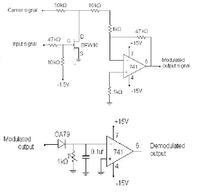Follow along with the video below to see how to install our site as a web app on your home screen.
Note: This feature may not be available in some browsers.
Without any net names in the schematic, we can only guess about waveform assignments. But the symbols suggest that you mixed up V0 and V1. In addition, did you consider that the M1 substrate diode will cut negative signal voltages?
ASK is basically a binary modulation. I don't understand how you want to modulate a square wave carrier with a sine message. In any case, the square wave should control the switch.
In simulation, you can use behavioral components like ideal switches, controlled sources and possibly multipliers. You don't need to refer to OPs or transistors. A real reader cicruit will look quite different anyway.
FVM is right, you have your circuit backwards. The drive to the FET should be your digital signal. The FET will short out the sine wave when it is ON, and will pass the sine wave when the FET is OFF.
Also, to actually send data on the sine wave carrier, the sine wave frequency has to be much higher than your data rate! Try the sine wave at 20x your data rate at least.
